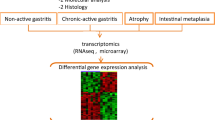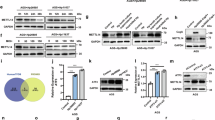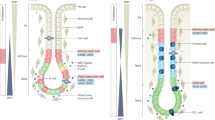Abstract
Background
Vasorin (VASN) is linked to tumor progression in various cancers, its role and regulatory mechanisms in gastric cancer (GC) are still unknown.
Methods
Human gastric mucosal samples, VASN heterozygous-deficient (VASN+/-) C57BL/6 mice, and gastric cell lines with VASN knockdown and overexpression were used to study VASN’s role in GC. A combination of in vitro and in vivo models, RNA sequencing (RNA-seq), proteomics, bioinformatics, and various assays revealed VASN’s critical involvement in GC.
Results
Elevated VASN expression was significantly associated with poor clinical outcomes in GC patients. We identified a strong correlation between increased VASN expression, driven by Helicobacter pylori (H. pylori) infection, and the progression of gastric carcinogenesis. Functional studies demonstrated that VASN overexpression enhanced the proliferation, migration, and invasion of gastric epithelial cells, whereas VASN knockdown suppressed these malignant phenotypes. Mechanistically, the collagen type IV alpha 1 chain (COL4A1) was identified as a critical downstream effector of VASN in GC. VASN exerted its oncogenic effects by regulating COL4A1 to activate the PI3K/AKT signaling pathway. Furthermore, H. pylori infection was demonstrated to induce hypoxia-inducible factor-1 alpha (HIF-1α) expression, which subsequently upregulated VASN.
Conclusions
The HIF-1α-VASN-COL4A1-PI3K/AKT signaling pathway is crucial for gastric tumor development and may represent a therapeutic target for GC.

This is a preview of subscription content, access via your institution
Access options
Subscribe to this journal
Receive 24 print issues and online access
269,00 € per year
only 11,21 € per issue
Buy this article
- Purchase on SpringerLink
- Instant access to full article PDF
Prices may be subject to local taxes which are calculated during checkout







Similar content being viewed by others
Data availability
The data that support the findings of this study are available from the corresponding author upon reasonable request.
References
Bray F, Laversanne M, Sung H, Ferlay J, Siegel RL, Soerjomataram I, et al. Global cancer statistics 2022: GLOBOCAN estimates of incidence and mortality worldwide for 36 cancers in 185 countries. CA Cancer J Clin. 2024;74:229–63.
Smyth EC, Nilsson M, Grabsch HI, van Grieken NC, Lordick F. Gastric cancer. Lancet. 2020;396:635–48.
Ugai T, Sasamoto N, Lee HY, Ando M, Song M, Tamimi RM, et al. Is early-onset cancer an emerging global epidemic? Current evidence and future implications. Nat Rev Clin Oncol. 2022;19:656–73.
Wang X, Zhao G, Shao S, Yao Y. Helicobacter pylori triggers inflammation and oncogenic transformation by perturbing the immune microenvironment. Biochim Biophys Acta Rev Cancer. 2024;1879:189139.
Malfertheiner P, Camargo MC, El-Omar E, Liou JM, Peek R, Schulz C, et al. Helicobacter pylori infection. Nat Rev Dis Prim. 2023;9:19.
Ikeda Y, Imai Y, Kumagai H, Nosaka T, Morikawa Y, Hisaoka T, et al. Vasorin, a transforming growth factor beta-binding protein expressed in vascular smooth muscle cells, modulates the arterial response to injury in vivo. Proc Natl Acad Sci USA. 2004;101:10732–7.
Bonnet AL, Chaussain C, Broutin I, Rochefort GY, Schrewe H, Gaucher C. From vascular smooth muscle cells to folliculogenesis: what about vasorin? Front Med (Lausanne) 2018;5:335.
Liang W, Zuo J, Liu M, Su Y, Guo B, Hou J, et al. VASN promotes colorectal cancer progression by activating the YAP/TAZ and AKT signaling pathways via YAP. FASEB J 2023;37:e22688.
Bhandari A, Guan Y, Xia E, Huang Q, Chen Y. VASN promotes YAP/TAZ and EMT pathway in thyroid carcinogenesis in vitro. Am J Transl Res 2019;11:3589–99.
Choksi S, Lin Y, Pobezinskaya Y, Chen L, Park C, Morgan M, et al. A HIF-1 target, ATIA, protects cells from apoptosis by modulating the mitochondrial thioredoxin, TRX2. Mol Cell. 2011;42:597–609.
Zhang Y, Kang T, Wang Y, Song C, Li H, Mi H, et al. Low level of tumor necrosis factor alpha in tumor microenvironment maintains self-renewal of glioma stem cells by Vasorin-mediated glycolysis. Neuro Oncol. 2024;26:2256–2271.
Man J, Yu X, Huang H, Zhou W, Xiang C, Huang H, et al. Hypoxic induction of vasorin regulates Notch1 turnover to maintain glioma stem-like cells. Cell Stem Cell. 2018;22:104–18.e6.
Wan F, Li H, Huang S, Sun J, Li J, Li Y, et al. Vasorin promotes proliferation and migration via STAT3 signaling and acts as a promising therapeutic target of hepatocellular carcinoma. Cell Signal. 2023;110:110809.
Cui FL, Mahmud AN, Xu ZP, Wang ZY, Hu JP. VASN promotes proliferation of prostate cancer through the YAP/TAZ axis. Eur Rev Med Pharm Sci. 2020;24:6589–96.
Jarvelainen H, Sainio A, Koulu M, Wight TN, Penttinen R. Extracellular matrix molecules: potential targets in pharmacotherapy. Pharm Rev. 2009;61:198–223.
Wang T, Jin H, Hu J, Li X, Ruan H, Xu H, et al. COL4A1 promotes the growth and metastasis of hepatocellular carcinoma cells by activating FAK-Src signaling. J Exp Clin Cancer Res. 2020;39:148.
Hu YZ, Hu ZL, Liao TY, Li Y, Pan YL. LncRNA SND1-IT1 facilitates TGF-beta1-induced epithelial-to-mesenchymal transition via miR-124/COL4A1 axis in gastric cancer. Cell Death Discov. 2022;8:73.
Ferrucci V, Asadzadeh F, Collina F, Siciliano R, Boccia A, Marrone L, et al. Prune-1 drives polarization of tumor-associated macrophages (TAMs) within the lung metastatic niche in triple-negative breast cancer. iScience. 2021;24:101938.
Miyake M, Hori S, Morizawa Y, Tatsumi Y, Toritsuka M, Ohnishi S, et al. Collagen type IV alpha 1 (COL4A1) and collagen type XIII alpha 1 (COL13A1) produced in cancer cells promote tumor budding at the invasion front in human urothelial carcinoma of the bladder. Oncotarget. 2017;8:36099–114.
Jin R, Shen J, Zhang T, Liu Q, Liao C, Ma H, et al. The highly expressed COL4A1 genes contributes to the proliferation and migration of the invasive ductal carcinomas. Oncotarget. 2017;8:58172–83.
Li X, Yu X, Bi J, Jiang X, Zhang L, Li Z, et al. Integrating single-cell and spatial transcriptomes reveals COL4A1/2 facilitates the spatial organisation of stromal cells differentiation in breast phyllodes tumours. Clin Transl Med. 2024;14:e1611.
Cui X, Shan T, Qiao L. Collagen type IV alpha 1 (COL4A1) silence hampers the invasion, migration and epithelial-mesenchymal transition (EMT) of gastric cancer cells through blocking Hedgehog signaling pathway. Bioengineered. 2022;13:8972–81.
Zhang H, Wang Y, Ding H. COL4A1, negatively regulated by XPD and miR-29a-3p, promotes cell proliferation, migration, invasion and epithelial-mesenchymal transition in liver cancer cells. Clin Transl Oncol. 2021;23:2078–89.
Li A, Li Y, Li Y, Zhang M, Zhang H, Chen F. Identification and validation of key genes associated with pathogenesis and prognosis of gastric cancer. PeerJ. 2023;11:e16243.
Eskandarion MR, Eskandarieh S, Shakoori Farahani A, Mahmoodzadeh H, Shahi F, Oghabian MA, et al. Prediction of novel biomarkers for gastric intestinal metaplasia and gastric adenocarcinoma using bioinformatics analysis. Heliyon. 2024;10:e30253.
Li N, Xu X, Zhan Y, Fei X, Ouyang Y, Zheng P, et al. YAP and beta-catenin cooperate to drive H. pylori-induced gastric tumorigenesis. Gut Microbes. 2023;15:2192501.
Noto JM, Piazuelo MB, Romero-Gallo J, Delgado AG, Suarez G, Akritidou K, et al. Targeting hypoxia-inducible factor-1 alpha suppresses Helicobacter pylori-induced gastric injury via attenuation of both cag-mediated microbial virulence and proinflammatory host responses. Gut Microbes. 2023;15:2263936.
Xiong H, Tian L, Zhao Z, Chen S, Zhao Q, Hong J, et al. The sinomenine enteric-coated microspheres suppressed the TLR/NF-kappaB signaling in DSS-induced experimental colitis. Int Immunopharmacol. 2017;50:251–62.
Rhodes DR, Yu J, Shanker K, Deshpande N, Varambally R, Ghosh D, et al. ONCOMINE: a cancer microarray database and integrated data-mining platform. Neoplasia. 2004;6:1–6.
Clough E, Barrett T. The gene expression omnibus database. Methods Mol Biol. 2016;1418:93–110.
Lanczky A, Gyorffy B. Web-based survival analysis tool tailored for medical research (KMplot): development and implementation. J Med Internet Res. 2021;23:e27633.
Tang Z, Li C, Kang B, Gao G, Li C, Zhang Z. GEPIA: a web server for cancer and normal gene expression profiling and interactive analyses. Nucleic Acids Res. 2017;45:W98–W102.
Li T, Fan J, Wang B, Traugh N, Chen Q, Liu JS, et al. TIMER: a web server for comprehensive analysis of tumor-infiltrating immune cells. Cancer Res. 2017;77:e108–e10.
Cerami E, Gao J, Dogrusoz U, Gross BE, Sumer SO, Aksoy BA, et al. The cBio cancer genomics portal: an open platform for exploring multidimensional cancer genomics data. Cancer Discov. 2012;2:401–4.
Liu C, Liu D, Wang F, Liu Y, Xie J, Xie J, et al. Construction of a novel choline metabolism-related signature to predict prognosis, immune landscape, and chemotherapy response in colon adenocarcinoma. Front Immunol. 2022;13:1038927.
Louvet L, Lenglet G, Krautzberger AM, Mentaverri R, Hague F, Kowalewski C, et al. Vasorin plays a critical role in vascular smooth muscle cells and arterial functions. J Cell Physiol. 2022;237:3845–59.
Sun J, Guo X, Yu P, Liang J, Mo Z, Zhang M, et al. Vasorin deficiency leads to cardiac hypertrophy by targeting MYL7 in young mice. J Cell Mol Med. 2022;26:88–98.
Amieva M, Peek RM Jr. Pathobiology of helicobacter pylori-induced gastric cancer. Gastroenterology. 2016;150:64–78.
Thrift AP, El-Serag HB. Burden of gastric cancer. Clin Gastroenterol Hepatol. 2020;18:534–42.
Zeng Y, Jin RU. Molecular pathogenesis, targeted therapies, and future perspectives for gastric cancer. Semin Cancer Biol. 2022;86:566–82.
Luo D, Liu Y, Lu Z, Huang L. Targeted therapy and immunotherapy for gastric cancer: rational strategies, novel advancements, challenges, and future perspectives. Mol Med. 2025;31:52.
Zhang Y, Fan W, Su F, Zhang X, Du Y, Li W, et al. Discussion on the mechanism of HER2 resistance in esophagogastric junction and gastric cancer in the era of immunotherapy. Hum Vaccin Immunother. 2025;21:2459458.
Saeed A, Park R, Sun W. The integration of immune checkpoint inhibitors with VEGF targeted agents in advanced gastric and gastroesophageal adenocarcinoma: a review on the rationale and results of early phase trials. J Hematol Oncol. 2021;14:13.
Li D, Zhang T, Yang X, Geng J, Li S, Ding H, et al. Identification of functional mimotopes of human vasorin ectodomain by biopanning. Int J Biol Sci. 2018;14:461–70.
Kang D, Huang S, Liao Y, Mi S, Zhou J, Feng Y, et al. Vasorin (VASN) overexpression promotes pulmonary metastasis and resistance to adjuvant chemotherapy in patients with locally advanced rectal cancer. J Transl Med. 2024;22:742.
Liang W, Guo B, Ye J, Liu H, Deng W, Lin C, et al. Vasorin stimulates malignant progression and angiogenesis in glioma. Cancer Sci. 2019;110:2558–72.
Khezri MR, Jafari R, Yousefi K, Zolbanin NM. The PI3K/AKT signaling pathway in cancer: molecular mechanisms and possible therapeutic interventions. Exp Mol Pathol. 2022;127:104787.
Morgos DT, Stefani C, Miricescu D, Greabu M, Stanciu S, Nica S, et al. Targeting PI3K/AKT/mTOR and MAPK signaling pathways in gastric cancer. Int J Mol Sci. 2024;25:1848.
Wroblewski LE, Peek RM Jr. Wilson KT. Helicobacter pylori and gastric cancer: factors that modulate disease risk. Clin Microbiol Rev. 2010;23:713–39.
Li M, Li G, Yang X, Yin W, Lv G, Wang S. HIF in gastric cancer: regulation and therapeutic target. Molecules. 2022;27:4893.
Zhao Y, Xing C, Deng Y, Ye C, Peng H. HIF-1alpha signaling: essential roles in tumorigenesis and implications in targeted therapies. Genes Dis. 2024;11:234–51.
Wen J, Wang Y, Gao C, Zhang G, You Q, Zhang W, et al. Helicobacter pylori infection promotes Aquaporin 3 expression via the ROS-HIF-1alpha-AQP3-ROS loop in stomach mucosa: a potential novel mechanism for cancer pathogenesis. Oncogene. 2018;37:3549–61.
Acknowledgements
Support for this work came from the Key Laboratory Project of Digestive Diseases in Jiangxi Province (2024SSY06101) and the Jiangxi Clinical Research Center for Gastroenterology (20223BCG74011). We appreciate Dr. Zhongming Ge for kindly providing the H. pylori 7.13 and PMSS1 strains. We also thank the TCGA, GEO, GEPIA, TIMER, Kaplan-Meier plotter and cBioPortal databases for providing data.
Funding
This research was funded by the National Natural Science Foundation of China (82270593), the China Postdoctoral Science Foundation (2023M731495), the Science and Technology Research Project of Jiangxi Provincial Department of Education (GJJ2400123) and the Science and Technology Plan of Jiangxi Provincial Health Commission (202510024).
Author information
Authors and Affiliations
Contributions
JL and YX were responsible for designing, conceiving, and supervising the study, and the experiments were conducted by RZ, JX, HC and XG. CP, JX, JP, JQ, CW, XG, HW, JR, WD and XW collected the clinical samples and contributed to the animal experiments. The bioinformatics analysis was conducted by CP, DL and SC. RZ drafted the manuscript, while JL and YX edited the paper.
Corresponding authors
Ethics declarations
Competing interests
The authors declare no competing interests.
Ethics approval and consents to participate
The study was approved by the Ethics Committee of The First Affiliated Hospital of Nanchang University (Approval No. 2020-1-64). All tissue samples were collected with informed consent. All studies involving animals were performed following the ARRIVE guidelines (https://arriveguidelines.org).
Additional information
Publisher’s note Springer Nature remains neutral with regard to jurisdictional claims in published maps and institutional affiliations.
Rights and permissions
Springer Nature or its licensor (e.g. a society or other partner) holds exclusive rights to this article under a publishing agreement with the author(s) or other rightsholder(s); author self-archiving of the accepted manuscript version of this article is solely governed by the terms of such publishing agreement and applicable law.
About this article
Cite this article
Zhao, R., Xie, J., Chen, H. et al. VASN drives gastric tumorigenesis via activation of the COL4A1/PI3K/AKT axis during Helicobacter pylori infection. Br J Cancer (2025). https://doi.org/10.1038/s41416-025-03081-7
Received:
Revised:
Accepted:
Published:
DOI: https://doi.org/10.1038/s41416-025-03081-7



